You may not find this terribly rewarding unless you're included here, so this is a good time for casual and random browsers to turn back before they get too caught up in the sweep and majesty of the proceedings and can't let go.

Our assault on the fortifications begins (2 November 2024).

Looming. As mentioned earlier, the fortification was commissioned by Pope Pius II Piccolomini in 1461 to be planted as a defensive anchor at a northern corner of the city walls, looking outward for unwelcome visitors and, apparently more importantly, inward towards the members and supporters of the competing armed families of the time, principally those of the far-flung Orsini and Colonna clans. It was sited on a prominence above a bend of the river Aniene along an ancient transhumance path dating from an Iron Age community of the 9th-7th centuries BC, herding livestock with the seasons between the Roman Compagna of the Lazio region and the Adriatic.

The bastion is original, covering for the original drawbridge across to the entrance one floor up. The walls and towers are original as well, as they were completed during the papacy of Alexander VI Borgia (1490s), and only the larger building that we'll see in the courtyard later was added in the 19th century.
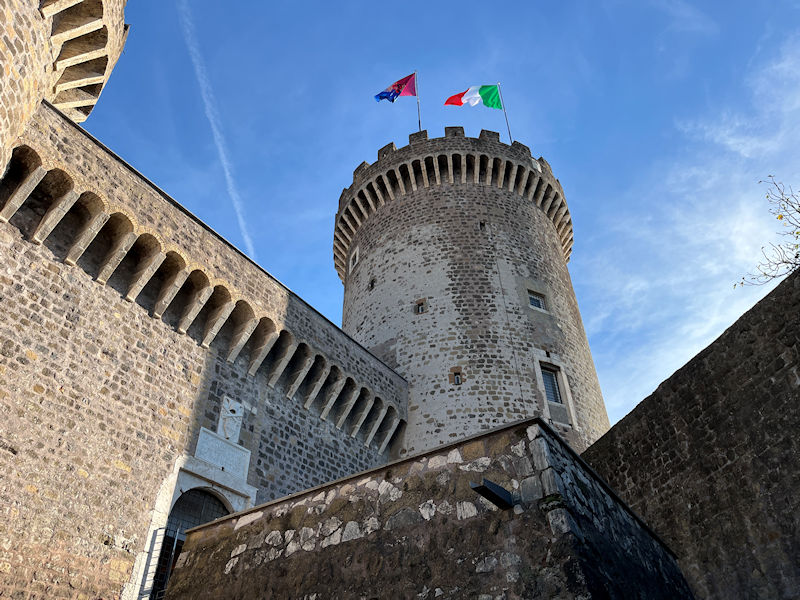
As will be seen, the restoration of the castle has been a fabulous feat of engineering, given its long life as a defensive structure, called upon several times to act the part, and later as a military barracks and most recently as a prison, right up to 1960. It's a strong and well-built castle, which even . . .
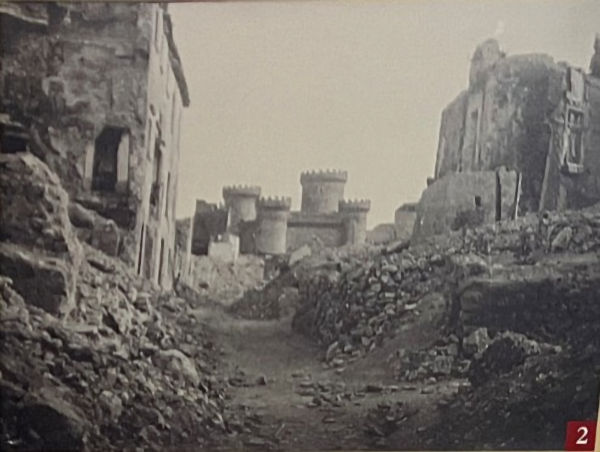
. . . pretty well survived the American bombing of the city in 1944 (taken from one of the information plaques).
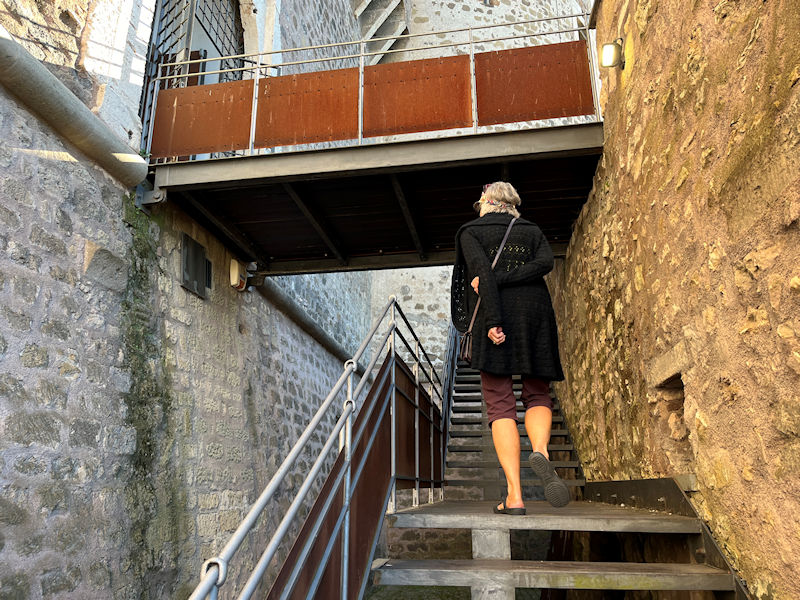
A new stairway onto the bastion and a modern replacement of the now unnecessary drawbridge, and . . .

. . . over the door, the coat of arms of Pius II and the legend in Latin: 'I am grateful to the good, hated by the evil, and hostile to the enemy'.


Straight into the kitchens

Here's a maquette of the earliest part of the city. The crossing of the Aniene is on the right -- the dam was built following a very serious flood in 1826, in pursuit of the brilliant idea of digging out a tunnel system on the right side of the dam under Monte Catillo to reroute the river out over the deep gorge beyond, creating the 'Great Waterfall'. Called the Gregorian Tunnels, they were inaugurated by Pope Gregory XVI in 1835.
The castle can be seen on the left side of the photo, the four towers adjacent to the former amphitheatre; our temporary flat is peeking out from under the red dot.

The same from another angle. At the bottom right is the Villa d'Este and its incredible gardens.

A window from the wall into the central building added in the courtyard in the 19th century.

And a peek down the stairs at what seems likely to have been an 'oubliette', a not-uncommon prison feature for dropping an especially intractable prisoner down the hole, throwing in some food and water from time to time, and forgetting about him.

A characteristic response

On the left: The first representation of the Rocca Pia, as it was still under construction, appears in a fresco by Andrea Mantegna in about 1465-1474, in the Camera degli Sposi or Bridal Room in the Castello di San Giorgio in Mantua.

According to the info plaque, the peak in the right background is meant to represent the acropolis of Palestrina (which is only about 10 miles south of Tivoli (but 250 miles south of Mantua)).

A mapping of Tivoli in the early 18th century, with the rocca on the walls in the upper right
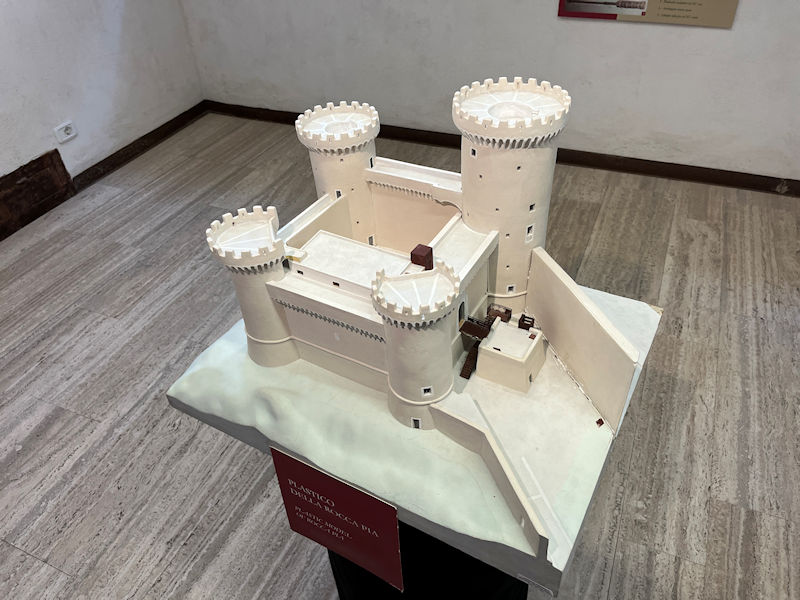
A maquette of the castle, with the city wall running off on the right (as it still does). The four towers of unequal heights are original, but the block building in the courtyard was added in the 19th century.

The rooms of the castle museum are dedicated to a fine poster display of many aspects of the rocca's history, as here the artillery facilities, as well as other types of smaller firearms in use; excavations made of Bronze and Iron Age settlements on the site; the background on the Amphitheatre of Blesus next door; the later life of the castle as a barracks and prison; the architectural plans of the castle's towers and foundations; photographs of the castle from the late 19th century to the US bombing of the city; the process of the castle's restoration after World War II. And et cetera.

There are also a few rooms of celebration of the life of Ignazio de Loyola, founder of the Society of Jesuits whose application for papal approval was orally conveyed here in the castle by Pope Paul III Farnese in 1539. For me an even more interesting background on Loyola's life involved his work as an arbitrator in a dispute between Margaret of Parma (aka of Austria, 1522-1586), who was born in the Netherlands, the illegitmate daughter of the Holy Roman Emperor; she became the Duchess of Florence by her first husband at 13 years old (Alessandro Medici, the Duke, was assassinated the next year) and then Duchess of Parma in 1547 as wife of the Farnese duke (married at 15 in 1538), and she served as Governor-General of the Habsburg Netherlands on behalf of her brother, Philip II of Spain, from 1559 to 1567 and again, jointly with her military son Alessandro the 3rd Duke, from 1578 to 1582. She also served during her interim from the Low Countries as Governor of Abruzzo and Viceroy of Naples.
Margaret had inherited properties in this region, and according to the info plaque, between 1548 and 1550 Margaret, described here as Lady of Castel Madama (a village 3 miles northeast), had legal disputes of some kind with the city of Tivoli, and Loyola was asked to serve as peacemaker. The portrait above is the classic one by Antonio Moro (Anthonis Mor) of Utrecht, 1562.

The wall walk

Period decorations in some of the towers

Contemplations at altitude

Castle scenes
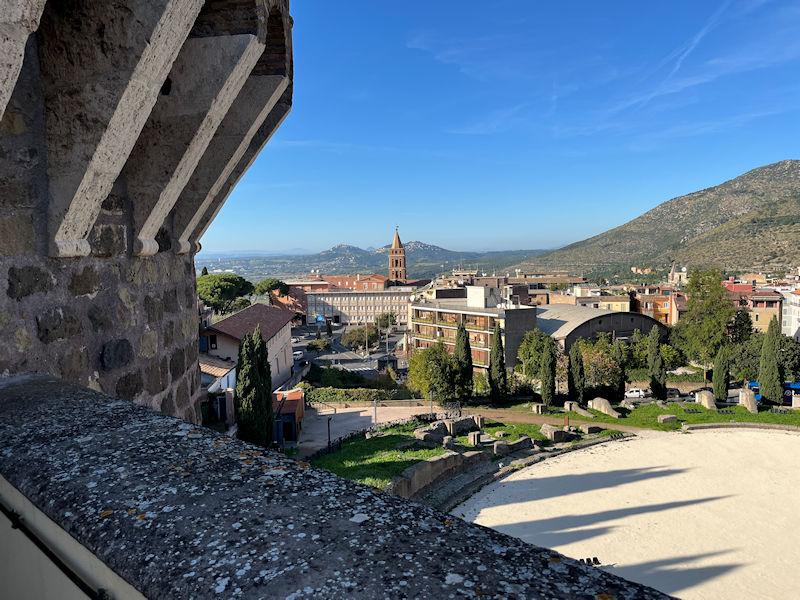
The Piazza Garibaldi and the Blesus amphitheatre below the castle
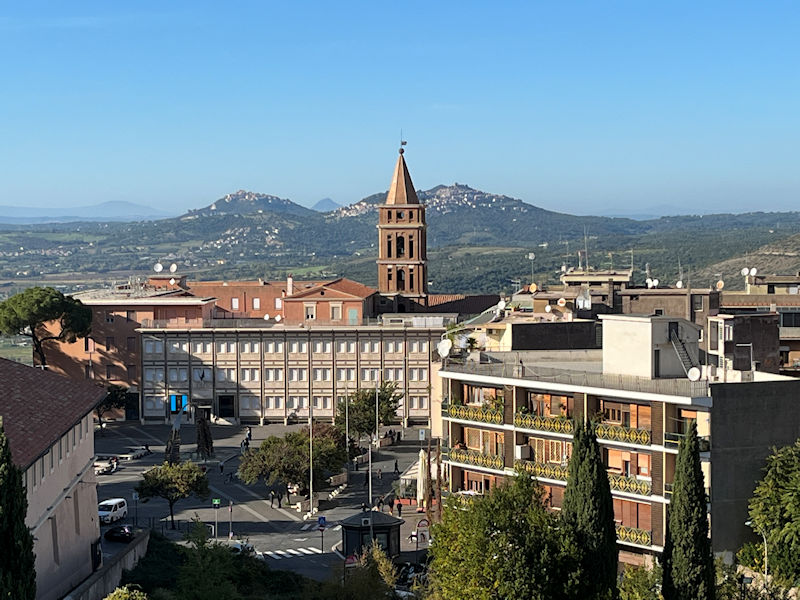
The Piazza Garibaldi from on high

Roughly 50 feet between the towers

-- Scusi, anybody home?

That's our week's digs across the road (red dots).

We're trying not to miss anything.

The large building with the staircase is the 19th century addition.


Perhaps we've been round the wall walk too many times.

Time to start down

The posters on the stairs are about the prison years but a little squinty to try to read without tripping on the stairs.

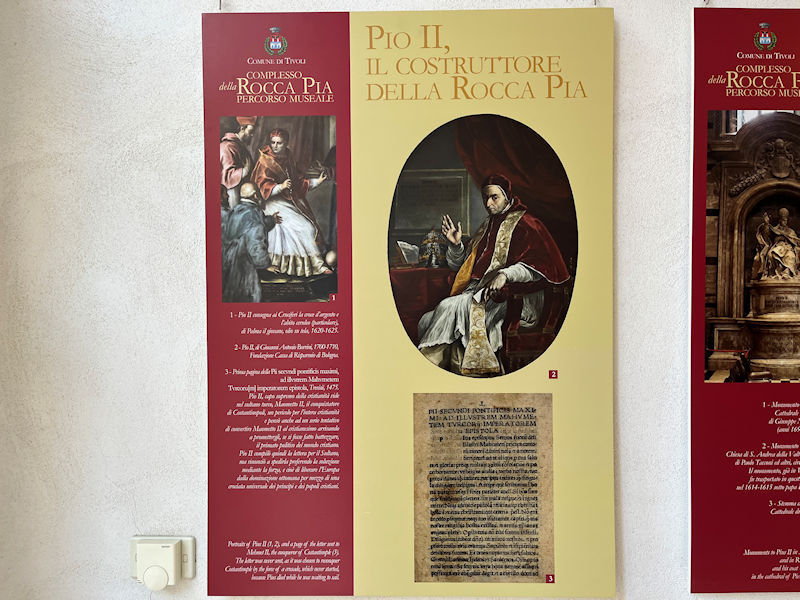
The strongest focus of the museum's attention is the man behind the building of the castle in 1461, Pope Pius II -- there are at least eight posters illustrating his illustrious career. The portrait is from the 18th century; the text is a letter that the pope was planning to send to the Ottoman Emperor Mehmet II (the fellow who'd conquered Constantinople in 1453), warning him to be a good citizen. It was never sent because the pope and council decided to send a new Crusading army instead.

Born in Siena, Aneas Silvius (aka Enea Silvio) Piccolomini -- the Holy Roman Emperor's poet laureate, erotic novelist, scholar and diplomat, later Bishop of Siena, eventually pope and would-be Crusader against the Turks, which finished him off -- has been remembered well by his birth city: the picture on the left shows the monument to him in the Siena Cathdral.
The picture on the right shows the cenotaph to Pope Pius II in the Basilica di Sant'Andrea della Valle in Rome. Pius II reigned as pope from 1458 to 1464; his nephew Francesco Todeschini (allowed to use the Piccolomini name) was appointed Archbishop of Siena at age 21 and later elected Pius III in 1503, but died a month afterward, the shortest papal term ever. Nevertheless, the authorities in Siena built two monster monuments for them, made to look very similar and placed directly across from one another. Unfortunately, we photographed the wrong one.

A youthful portrait of the pope, and below, the Piccolomini Library in the Duomo of Siena, created by his nephew the future Pius III to house the books and papers of his uncle. It's decorated with frescoes by Pinturicchio and assistants between 1501 and 1507 to illustrate many of the most important moments of the pope's life, like his diplomatic mission in 1435 to the court of James I of Scotland, his poetry laurel bestowed by Emperor Frederick III in 1442, his canonizing of Catherine of Siena in 1461, his performance at the Council of Mantua in 1459 as he was trying to convince European heads of state to send troops for a new Crusade against the Ottomans.
There was virtually no general interest in a new Crusade, but the pope retained his hopes. He died of a fever, at the age of 58, in Ancona, waiting for the armies and fleets to arrive, which they mostly didn't. The cardinals decided to give the small fortune in cash that he had brought for the Crusade to Matthias Corvinus of Hungary instead, as the Ottomans' frequent target.

The top left picture on the centre poster shows Pius canonizing Catherine of Siena and on the right side, the pope arriving in Ancona to initiate the Crusade that never happened. The detail from the Catherine picture shows the painters Raphael and Pinturicchio enjoying the party.

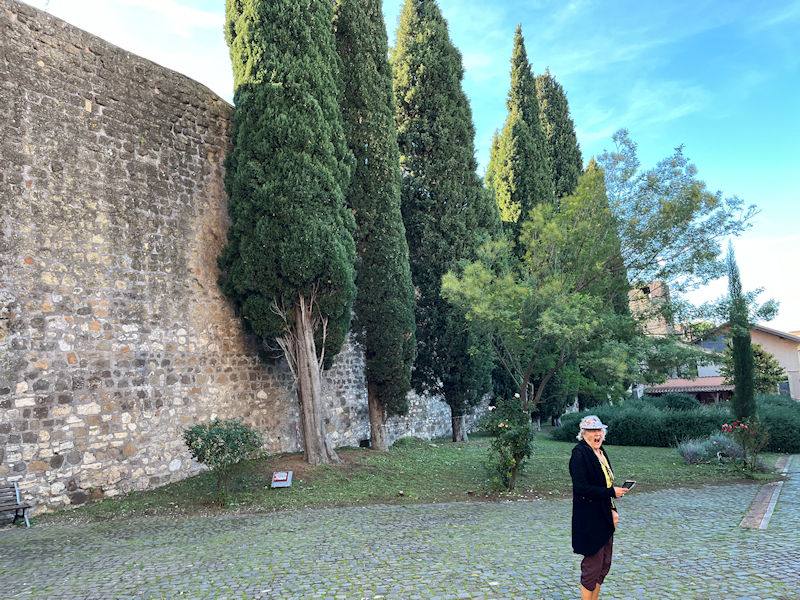
So much to see there -- it can be tiring.
That's a remaining part of the old city wall. Up on the left.

With the back of a restaurant that faces onto the street on the other side. The broken tower is another survivor of the old wall.
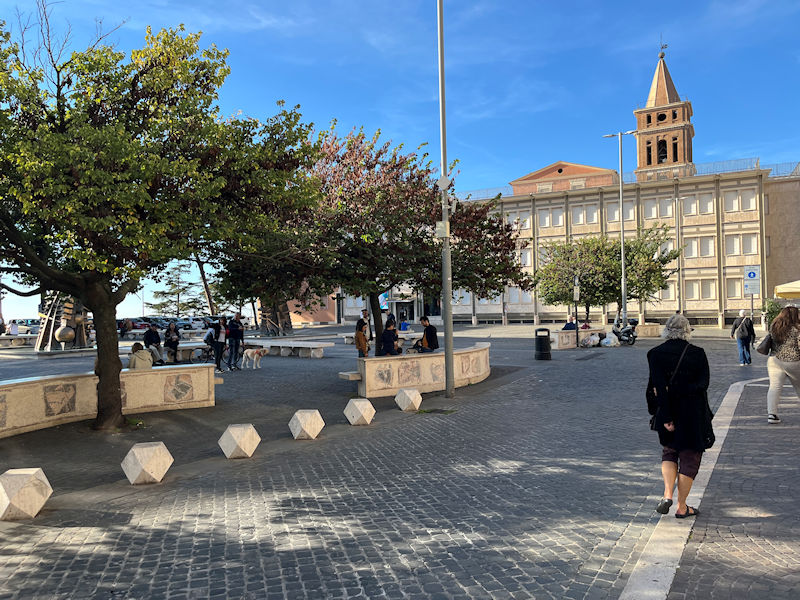
Now for a restorative walk round the neighborhood -- the Piazza Garibaldi above, and . . .
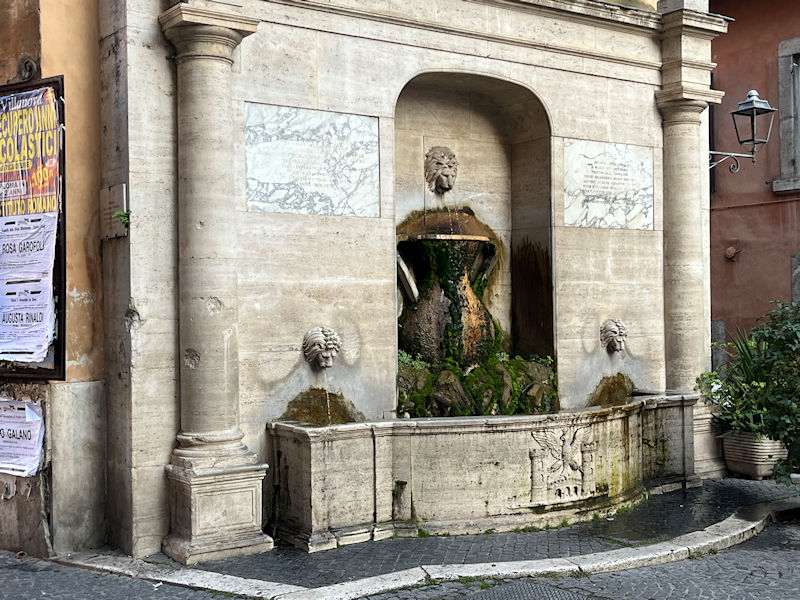
. . . the grotty old Fountain of the Three Lions at the intersection of the Via Palatina and the Via dei Sosii, taken from in front of the Tivoli Tasty Kebab and Pizza and the Vanity Hair and Beauty Lab

SPQT -- 'Senatus Populusque Tiburtinorum'? The main city hall of Tivoli, between the Via del Governo and the Piazza del Comune (a block from the Villa d'Este gardens)

And in the all-modern Piazza del Governo, just round the corner . . .

. . . attached to the post-war city hall, a reminder of the past that the bombers somehow missed.
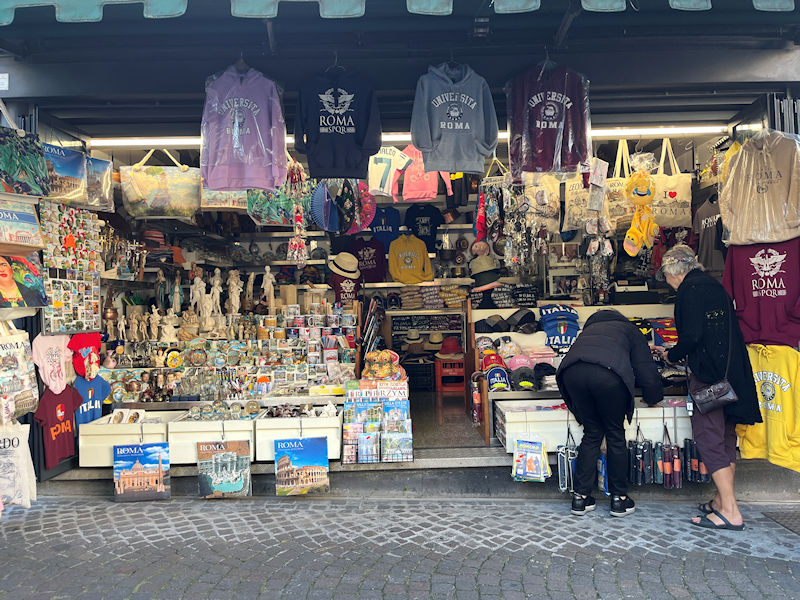
At a souvenir shop on the Viale Mannelli leading up home from the Parco Garibaldi, a helpful merchant accommodates Kristin's need for funny T-shirts for her two year old grandson. There's nearly everything here in the crowded shop, including . . .

. . . some items not suitable for two year olds.

Consulting the menu, carefully, and approving, so . . .

. . . a few hours later, here we are in the Angolino di Mirko.

The usual Italian restaurant wall decorations -- an army of wine bottles

The next morning, 3 November 2024: 'Get up, sweet-Slug-a-bed'
'come, let's goe a Maying'

That looks like a disused airplane hanger (we couldn't find out what it really was, or even still is). Our visitors will be here soon.

Ludovika, Kristin's step-daughter, and her son Elier have come up from Fregene to join us for the day.

Elier is an amazing lad, intelligent, witty, funny, and learning English enthusiastically.
(Kristin's been gifting him with suitable amusing English-language learner books.)

Having just thundered through a basket full of Rocca Pia photos, we needn't repeat all that here, but . . .

. . . we're still very pleased that they've come up to spend some time with us. We just wish that Elier's dad Javier could have got free to join them this time.
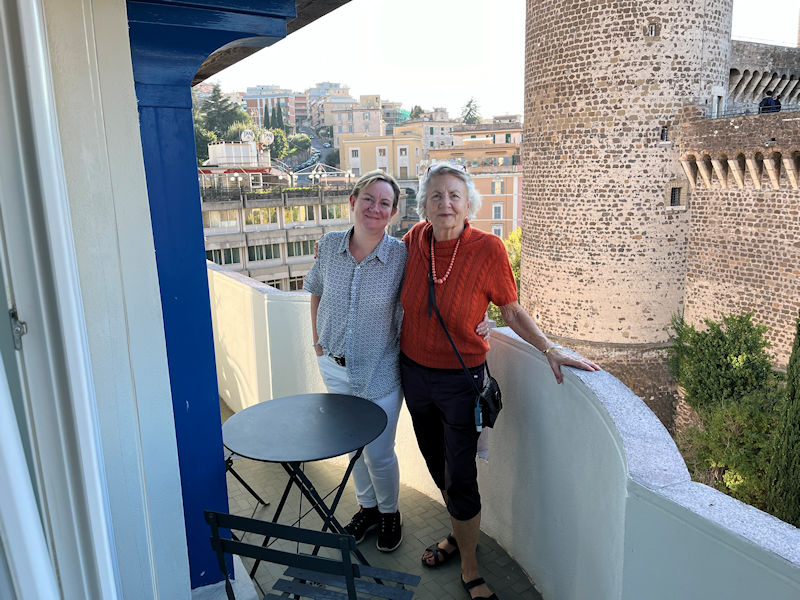
Until next time. Possibly in the US, who knows?

Ica and Elier have left, and we've just had dinner at the Ristorante da Sandrina on the Via Due Giugno, just two blocks down from the castle.

Which the city has wisely chosen to show off to best advantage in the evening.
Next up: The amazing Villa d'Este
 Dwight Peck's personal website
Dwight Peck's personal website






























































































